Economics Report: Industrial Workers Education & Data Visualization
VerifiedAdded on 2023/06/03
|7
|1429
|193
Report
AI Summary
This report addresses two key topics in economics. First, it examines the significance of education for industrial workers in developing countries, particularly in the context of trade liberalization. It discusses how higher education can impact wage inequality and the distribution of wealth, referencing studies on trade liberalization's effects on skilled and unskilled labor. The report concludes that education is crucial for industrial workers in developing economies, providing them with better opportunities and higher incomes, especially with government focus on higher education. Second, the report serves as an economist's guide to data visualization, emphasizing its importance in presenting data effectively and reducing misinterpretation. It highlights the benefits of using various charts and diagrams to communicate complex information and improve learning. The report also underscores the importance of selecting appropriate colors, fonts, software, and layouts to enhance the effectiveness of data visualization, noting that economists, who frequently work with data, can greatly benefit from these techniques. Desklib provides similar solved assignments for students.
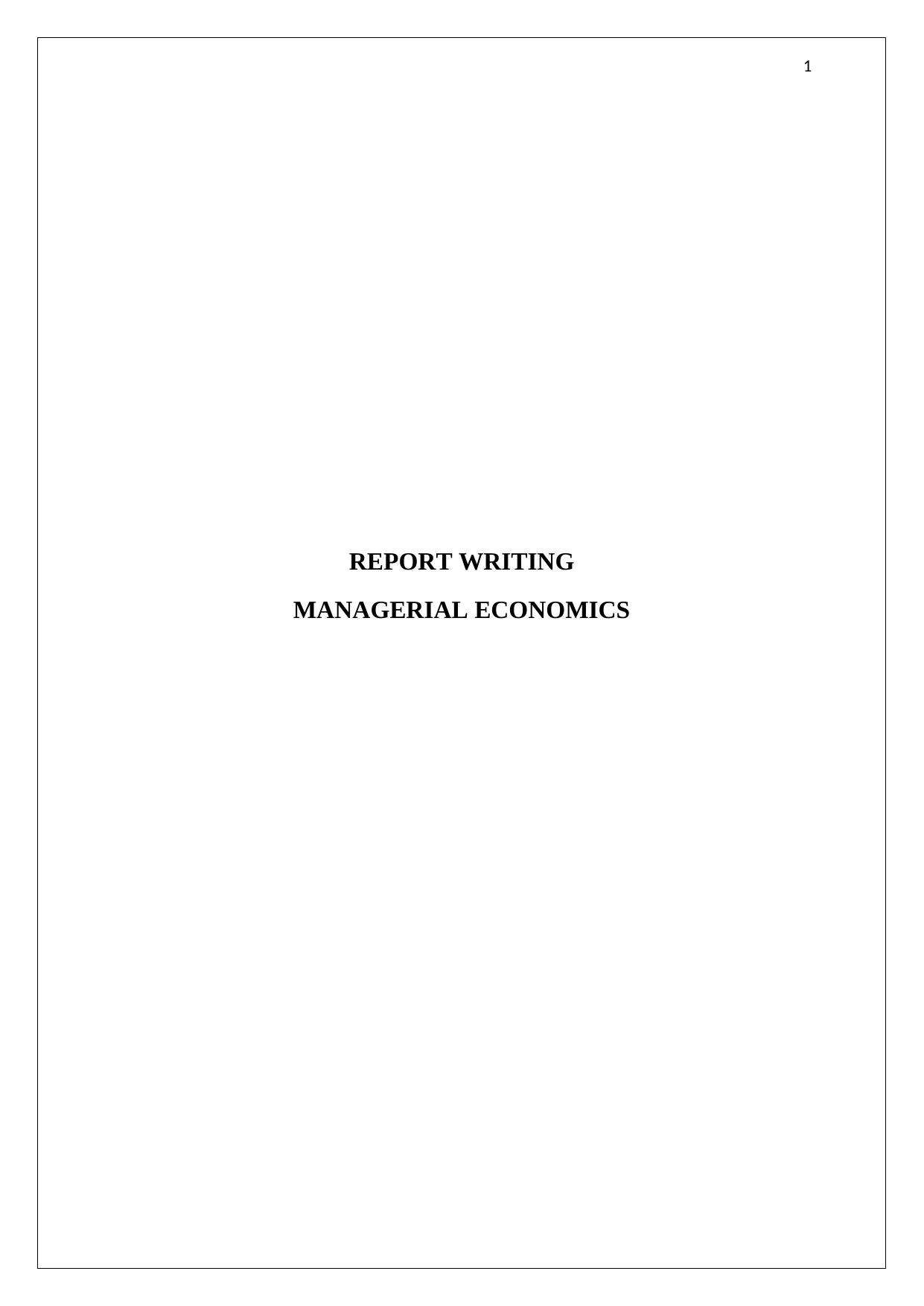
1
REPORT WRITING
MANAGERIAL ECONOMICS
REPORT WRITING
MANAGERIAL ECONOMICS
Paraphrase This Document
Need a fresh take? Get an instant paraphrase of this document with our AI Paraphraser
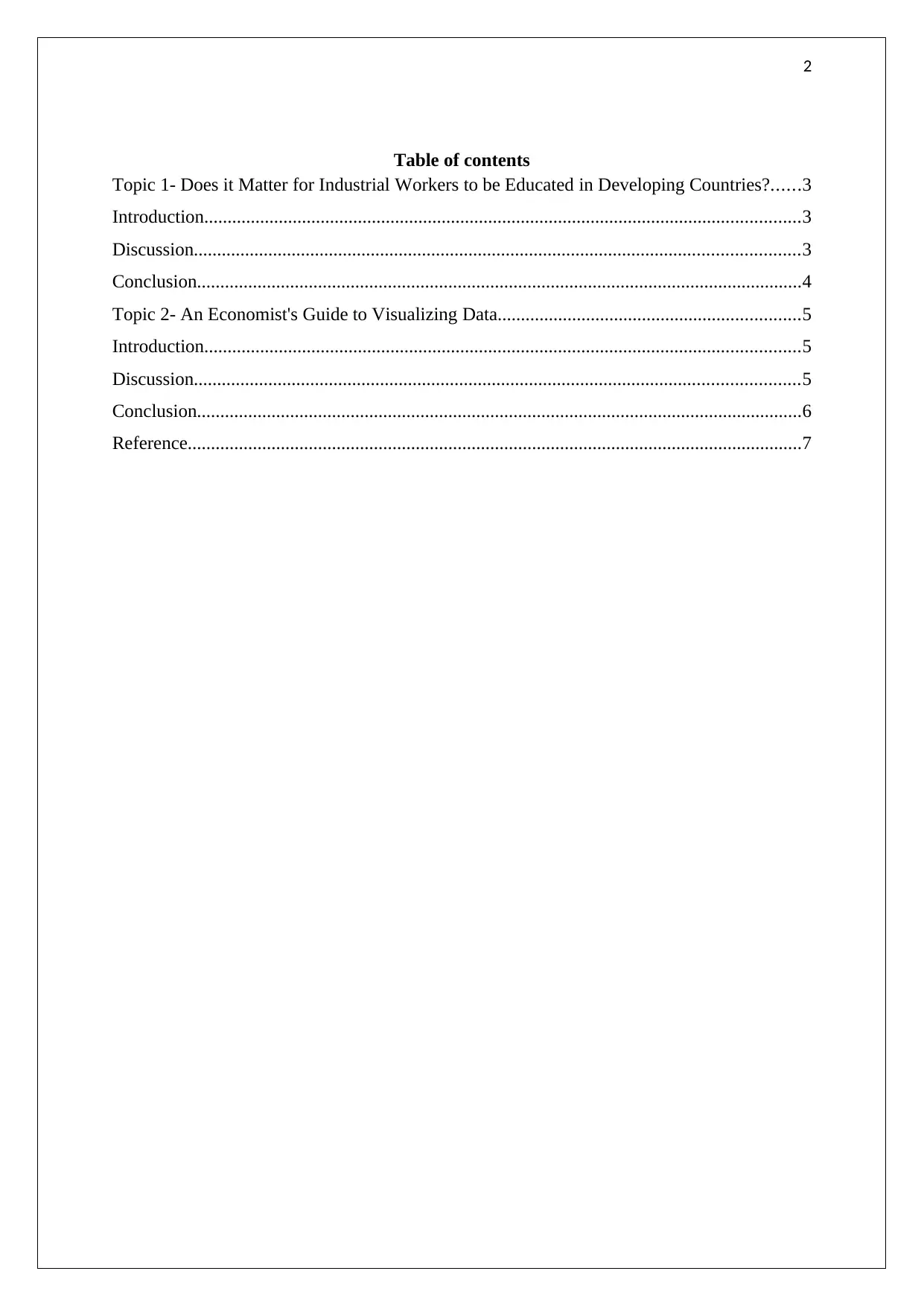
2
Table of contents
Topic 1- Does it Matter for Industrial Workers to be Educated in Developing Countries?......3
Introduction................................................................................................................................3
Discussion..................................................................................................................................3
Conclusion..................................................................................................................................4
Topic 2- An Economist's Guide to Visualizing Data.................................................................5
Introduction................................................................................................................................5
Discussion..................................................................................................................................5
Conclusion..................................................................................................................................6
Reference....................................................................................................................................7
Table of contents
Topic 1- Does it Matter for Industrial Workers to be Educated in Developing Countries?......3
Introduction................................................................................................................................3
Discussion..................................................................................................................................3
Conclusion..................................................................................................................................4
Topic 2- An Economist's Guide to Visualizing Data.................................................................5
Introduction................................................................................................................................5
Discussion..................................................................................................................................5
Conclusion..................................................................................................................................6
Reference....................................................................................................................................7
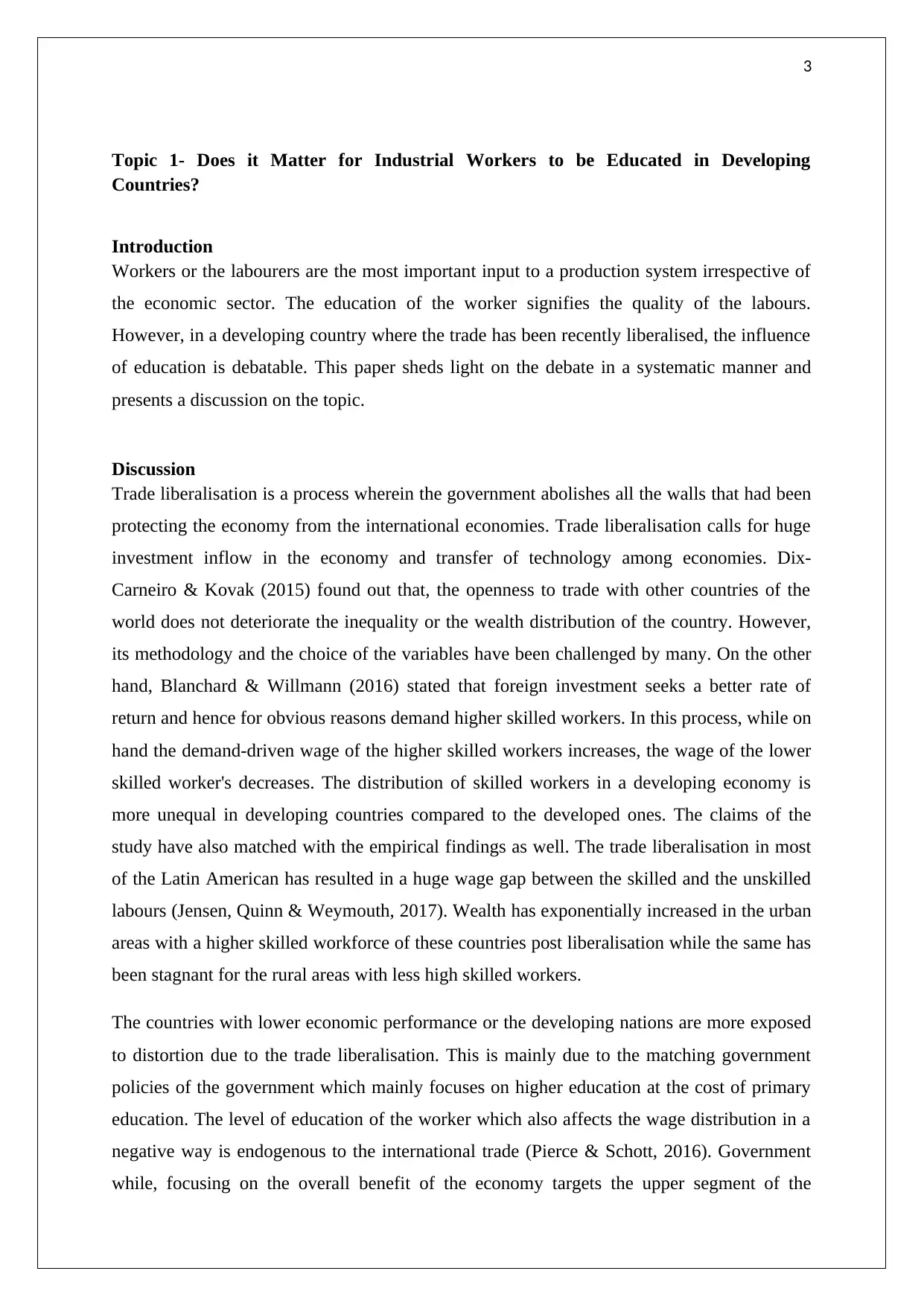
3
Topic 1- Does it Matter for Industrial Workers to be Educated in Developing
Countries?
Introduction
Workers or the labourers are the most important input to a production system irrespective of
the economic sector. The education of the worker signifies the quality of the labours.
However, in a developing country where the trade has been recently liberalised, the influence
of education is debatable. This paper sheds light on the debate in a systematic manner and
presents a discussion on the topic.
Discussion
Trade liberalisation is a process wherein the government abolishes all the walls that had been
protecting the economy from the international economies. Trade liberalisation calls for huge
investment inflow in the economy and transfer of technology among economies. Dix-
Carneiro & Kovak (2015) found out that, the openness to trade with other countries of the
world does not deteriorate the inequality or the wealth distribution of the country. However,
its methodology and the choice of the variables have been challenged by many. On the other
hand, Blanchard & Willmann (2016) stated that foreign investment seeks a better rate of
return and hence for obvious reasons demand higher skilled workers. In this process, while on
hand the demand-driven wage of the higher skilled workers increases, the wage of the lower
skilled worker's decreases. The distribution of skilled workers in a developing economy is
more unequal in developing countries compared to the developed ones. The claims of the
study have also matched with the empirical findings as well. The trade liberalisation in most
of the Latin American has resulted in a huge wage gap between the skilled and the unskilled
labours (Jensen, Quinn & Weymouth, 2017). Wealth has exponentially increased in the urban
areas with a higher skilled workforce of these countries post liberalisation while the same has
been stagnant for the rural areas with less high skilled workers.
The countries with lower economic performance or the developing nations are more exposed
to distortion due to the trade liberalisation. This is mainly due to the matching government
policies of the government which mainly focuses on higher education at the cost of primary
education. The level of education of the worker which also affects the wage distribution in a
negative way is endogenous to the international trade (Pierce & Schott, 2016). Government
while, focusing on the overall benefit of the economy targets the upper segment of the
Topic 1- Does it Matter for Industrial Workers to be Educated in Developing
Countries?
Introduction
Workers or the labourers are the most important input to a production system irrespective of
the economic sector. The education of the worker signifies the quality of the labours.
However, in a developing country where the trade has been recently liberalised, the influence
of education is debatable. This paper sheds light on the debate in a systematic manner and
presents a discussion on the topic.
Discussion
Trade liberalisation is a process wherein the government abolishes all the walls that had been
protecting the economy from the international economies. Trade liberalisation calls for huge
investment inflow in the economy and transfer of technology among economies. Dix-
Carneiro & Kovak (2015) found out that, the openness to trade with other countries of the
world does not deteriorate the inequality or the wealth distribution of the country. However,
its methodology and the choice of the variables have been challenged by many. On the other
hand, Blanchard & Willmann (2016) stated that foreign investment seeks a better rate of
return and hence for obvious reasons demand higher skilled workers. In this process, while on
hand the demand-driven wage of the higher skilled workers increases, the wage of the lower
skilled worker's decreases. The distribution of skilled workers in a developing economy is
more unequal in developing countries compared to the developed ones. The claims of the
study have also matched with the empirical findings as well. The trade liberalisation in most
of the Latin American has resulted in a huge wage gap between the skilled and the unskilled
labours (Jensen, Quinn & Weymouth, 2017). Wealth has exponentially increased in the urban
areas with a higher skilled workforce of these countries post liberalisation while the same has
been stagnant for the rural areas with less high skilled workers.
The countries with lower economic performance or the developing nations are more exposed
to distortion due to the trade liberalisation. This is mainly due to the matching government
policies of the government which mainly focuses on higher education at the cost of primary
education. The level of education of the worker which also affects the wage distribution in a
negative way is endogenous to the international trade (Pierce & Schott, 2016). Government
while, focusing on the overall benefit of the economy targets the upper segment of the
⊘ This is a preview!⊘
Do you want full access?
Subscribe today to unlock all pages.

Trusted by 1+ million students worldwide
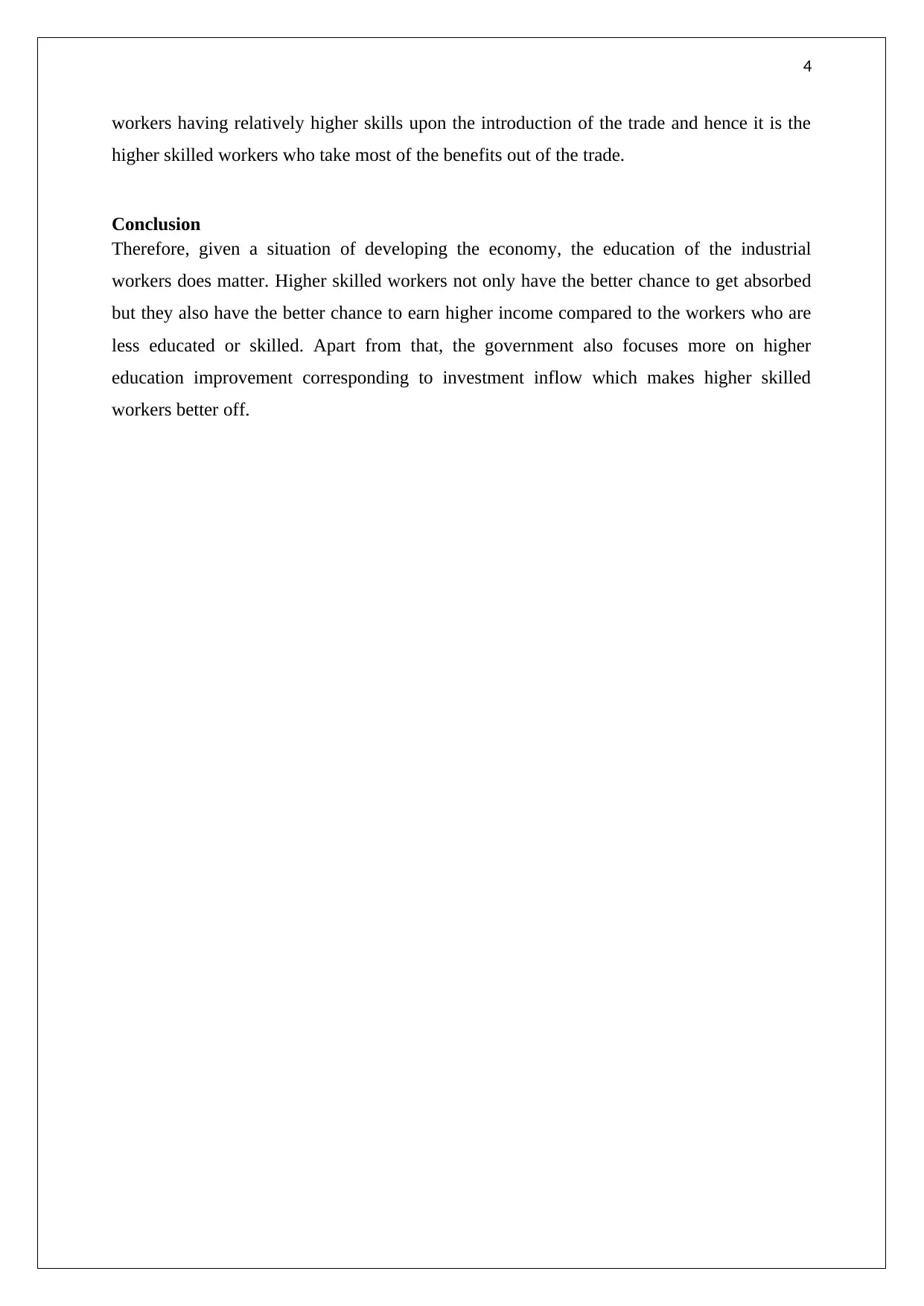
4
workers having relatively higher skills upon the introduction of the trade and hence it is the
higher skilled workers who take most of the benefits out of the trade.
Conclusion
Therefore, given a situation of developing the economy, the education of the industrial
workers does matter. Higher skilled workers not only have the better chance to get absorbed
but they also have the better chance to earn higher income compared to the workers who are
less educated or skilled. Apart from that, the government also focuses more on higher
education improvement corresponding to investment inflow which makes higher skilled
workers better off.
workers having relatively higher skills upon the introduction of the trade and hence it is the
higher skilled workers who take most of the benefits out of the trade.
Conclusion
Therefore, given a situation of developing the economy, the education of the industrial
workers does matter. Higher skilled workers not only have the better chance to get absorbed
but they also have the better chance to earn higher income compared to the workers who are
less educated or skilled. Apart from that, the government also focuses more on higher
education improvement corresponding to investment inflow which makes higher skilled
workers better off.
Paraphrase This Document
Need a fresh take? Get an instant paraphrase of this document with our AI Paraphraser
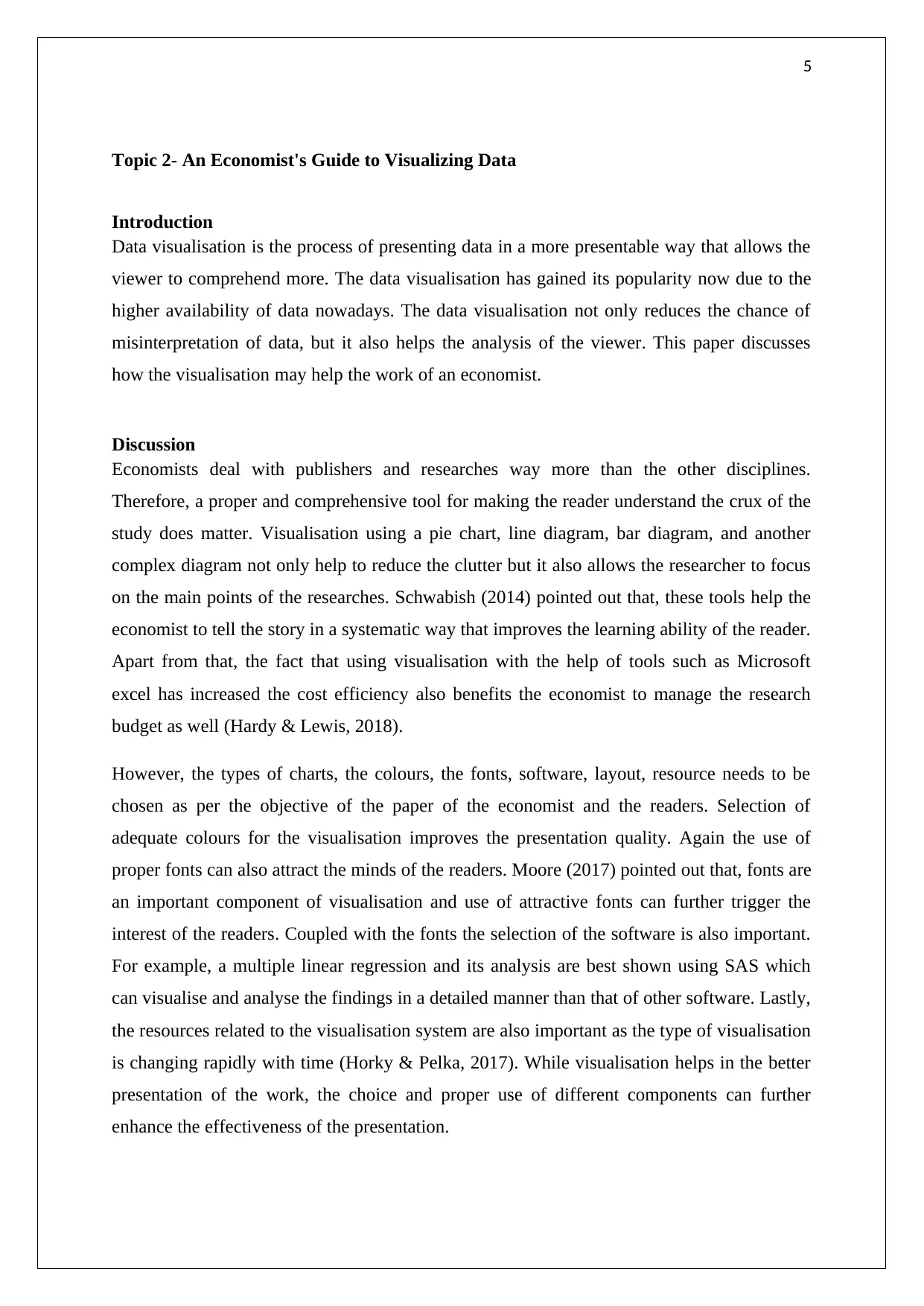
5
Topic 2- An Economist's Guide to Visualizing Data
Introduction
Data visualisation is the process of presenting data in a more presentable way that allows the
viewer to comprehend more. The data visualisation has gained its popularity now due to the
higher availability of data nowadays. The data visualisation not only reduces the chance of
misinterpretation of data, but it also helps the analysis of the viewer. This paper discusses
how the visualisation may help the work of an economist.
Discussion
Economists deal with publishers and researches way more than the other disciplines.
Therefore, a proper and comprehensive tool for making the reader understand the crux of the
study does matter. Visualisation using a pie chart, line diagram, bar diagram, and another
complex diagram not only help to reduce the clutter but it also allows the researcher to focus
on the main points of the researches. Schwabish (2014) pointed out that, these tools help the
economist to tell the story in a systematic way that improves the learning ability of the reader.
Apart from that, the fact that using visualisation with the help of tools such as Microsoft
excel has increased the cost efficiency also benefits the economist to manage the research
budget as well (Hardy & Lewis, 2018).
However, the types of charts, the colours, the fonts, software, layout, resource needs to be
chosen as per the objective of the paper of the economist and the readers. Selection of
adequate colours for the visualisation improves the presentation quality. Again the use of
proper fonts can also attract the minds of the readers. Moore (2017) pointed out that, fonts are
an important component of visualisation and use of attractive fonts can further trigger the
interest of the readers. Coupled with the fonts the selection of the software is also important.
For example, a multiple linear regression and its analysis are best shown using SAS which
can visualise and analyse the findings in a detailed manner than that of other software. Lastly,
the resources related to the visualisation system are also important as the type of visualisation
is changing rapidly with time (Horky & Pelka, 2017). While visualisation helps in the better
presentation of the work, the choice and proper use of different components can further
enhance the effectiveness of the presentation.
Topic 2- An Economist's Guide to Visualizing Data
Introduction
Data visualisation is the process of presenting data in a more presentable way that allows the
viewer to comprehend more. The data visualisation has gained its popularity now due to the
higher availability of data nowadays. The data visualisation not only reduces the chance of
misinterpretation of data, but it also helps the analysis of the viewer. This paper discusses
how the visualisation may help the work of an economist.
Discussion
Economists deal with publishers and researches way more than the other disciplines.
Therefore, a proper and comprehensive tool for making the reader understand the crux of the
study does matter. Visualisation using a pie chart, line diagram, bar diagram, and another
complex diagram not only help to reduce the clutter but it also allows the researcher to focus
on the main points of the researches. Schwabish (2014) pointed out that, these tools help the
economist to tell the story in a systematic way that improves the learning ability of the reader.
Apart from that, the fact that using visualisation with the help of tools such as Microsoft
excel has increased the cost efficiency also benefits the economist to manage the research
budget as well (Hardy & Lewis, 2018).
However, the types of charts, the colours, the fonts, software, layout, resource needs to be
chosen as per the objective of the paper of the economist and the readers. Selection of
adequate colours for the visualisation improves the presentation quality. Again the use of
proper fonts can also attract the minds of the readers. Moore (2017) pointed out that, fonts are
an important component of visualisation and use of attractive fonts can further trigger the
interest of the readers. Coupled with the fonts the selection of the software is also important.
For example, a multiple linear regression and its analysis are best shown using SAS which
can visualise and analyse the findings in a detailed manner than that of other software. Lastly,
the resources related to the visualisation system are also important as the type of visualisation
is changing rapidly with time (Horky & Pelka, 2017). While visualisation helps in the better
presentation of the work, the choice and proper use of different components can further
enhance the effectiveness of the presentation.
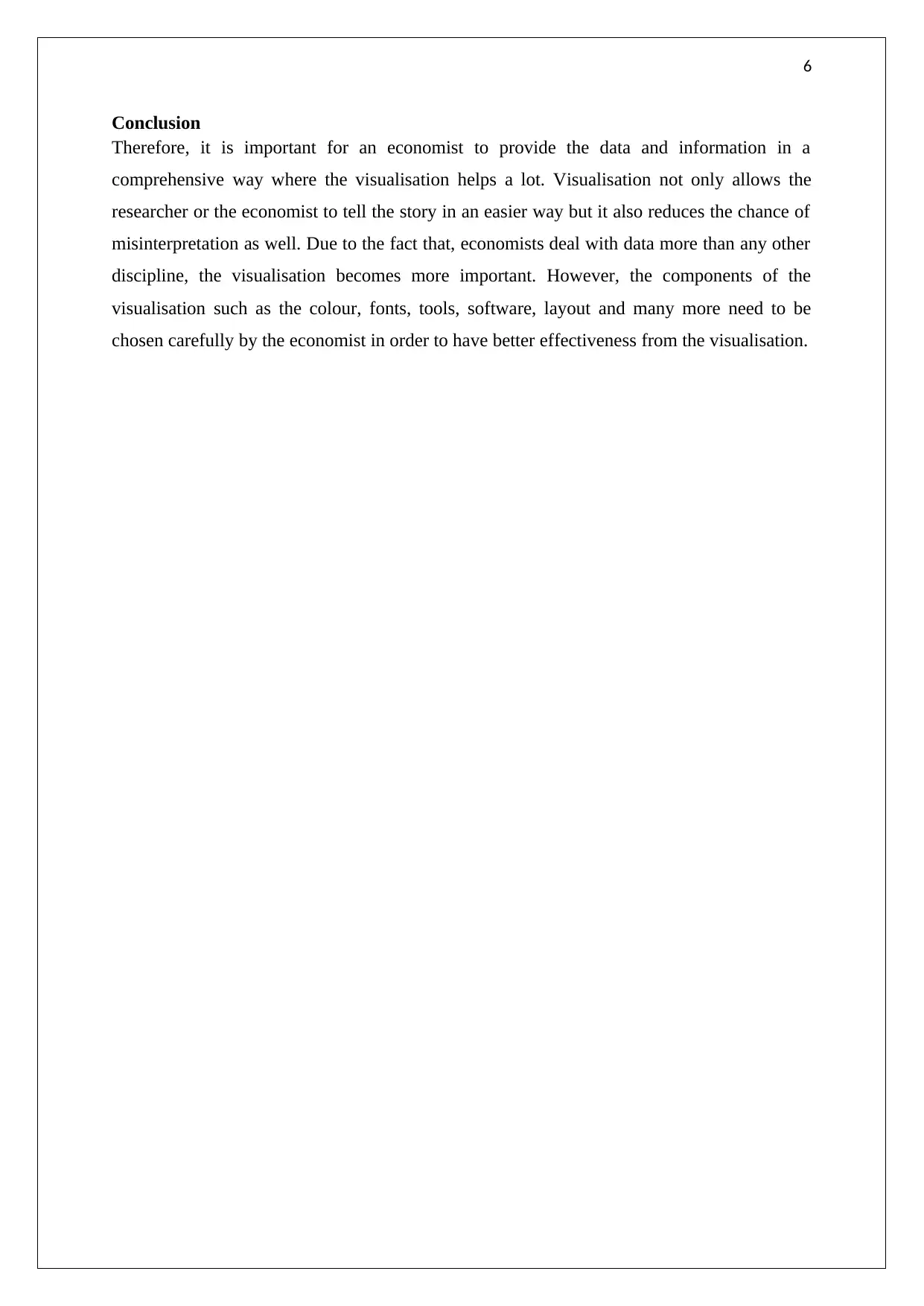
6
Conclusion
Therefore, it is important for an economist to provide the data and information in a
comprehensive way where the visualisation helps a lot. Visualisation not only allows the
researcher or the economist to tell the story in an easier way but it also reduces the chance of
misinterpretation as well. Due to the fact that, economists deal with data more than any other
discipline, the visualisation becomes more important. However, the components of the
visualisation such as the colour, fonts, tools, software, layout and many more need to be
chosen carefully by the economist in order to have better effectiveness from the visualisation.
Conclusion
Therefore, it is important for an economist to provide the data and information in a
comprehensive way where the visualisation helps a lot. Visualisation not only allows the
researcher or the economist to tell the story in an easier way but it also reduces the chance of
misinterpretation as well. Due to the fact that, economists deal with data more than any other
discipline, the visualisation becomes more important. However, the components of the
visualisation such as the colour, fonts, tools, software, layout and many more need to be
chosen carefully by the economist in order to have better effectiveness from the visualisation.
⊘ This is a preview!⊘
Do you want full access?
Subscribe today to unlock all pages.

Trusted by 1+ million students worldwide
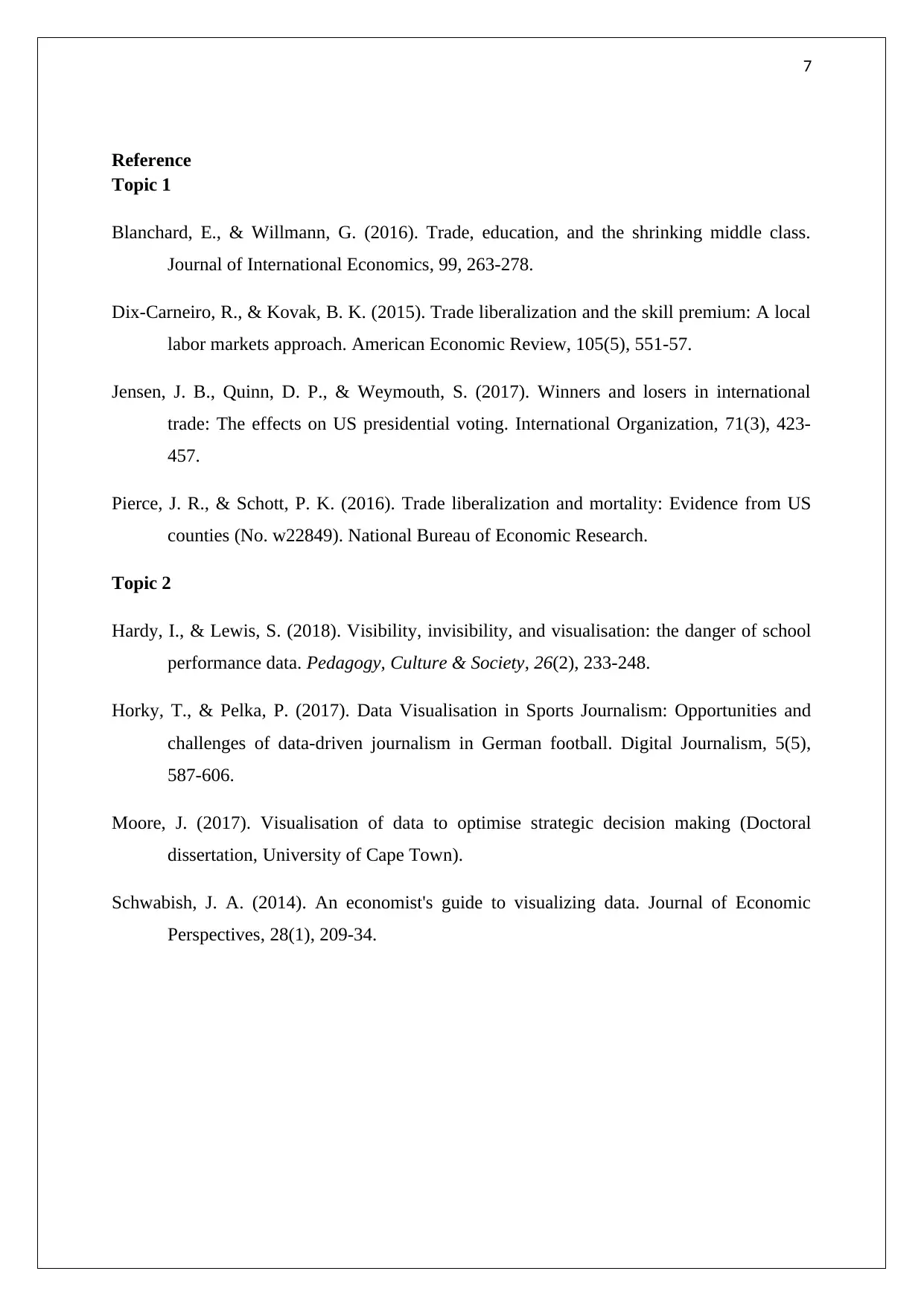
7
Reference
Topic 1
Blanchard, E., & Willmann, G. (2016). Trade, education, and the shrinking middle class.
Journal of International Economics, 99, 263-278.
Dix-Carneiro, R., & Kovak, B. K. (2015). Trade liberalization and the skill premium: A local
labor markets approach. American Economic Review, 105(5), 551-57.
Jensen, J. B., Quinn, D. P., & Weymouth, S. (2017). Winners and losers in international
trade: The effects on US presidential voting. International Organization, 71(3), 423-
457.
Pierce, J. R., & Schott, P. K. (2016). Trade liberalization and mortality: Evidence from US
counties (No. w22849). National Bureau of Economic Research.
Topic 2
Hardy, I., & Lewis, S. (2018). Visibility, invisibility, and visualisation: the danger of school
performance data. Pedagogy, Culture & Society, 26(2), 233-248.
Horky, T., & Pelka, P. (2017). Data Visualisation in Sports Journalism: Opportunities and
challenges of data-driven journalism in German football. Digital Journalism, 5(5),
587-606.
Moore, J. (2017). Visualisation of data to optimise strategic decision making (Doctoral
dissertation, University of Cape Town).
Schwabish, J. A. (2014). An economist's guide to visualizing data. Journal of Economic
Perspectives, 28(1), 209-34.
Reference
Topic 1
Blanchard, E., & Willmann, G. (2016). Trade, education, and the shrinking middle class.
Journal of International Economics, 99, 263-278.
Dix-Carneiro, R., & Kovak, B. K. (2015). Trade liberalization and the skill premium: A local
labor markets approach. American Economic Review, 105(5), 551-57.
Jensen, J. B., Quinn, D. P., & Weymouth, S. (2017). Winners and losers in international
trade: The effects on US presidential voting. International Organization, 71(3), 423-
457.
Pierce, J. R., & Schott, P. K. (2016). Trade liberalization and mortality: Evidence from US
counties (No. w22849). National Bureau of Economic Research.
Topic 2
Hardy, I., & Lewis, S. (2018). Visibility, invisibility, and visualisation: the danger of school
performance data. Pedagogy, Culture & Society, 26(2), 233-248.
Horky, T., & Pelka, P. (2017). Data Visualisation in Sports Journalism: Opportunities and
challenges of data-driven journalism in German football. Digital Journalism, 5(5),
587-606.
Moore, J. (2017). Visualisation of data to optimise strategic decision making (Doctoral
dissertation, University of Cape Town).
Schwabish, J. A. (2014). An economist's guide to visualizing data. Journal of Economic
Perspectives, 28(1), 209-34.
1 out of 7
Related Documents
Your All-in-One AI-Powered Toolkit for Academic Success.
+13062052269
info@desklib.com
Available 24*7 on WhatsApp / Email
![[object Object]](/_next/static/media/star-bottom.7253800d.svg)
Unlock your academic potential
Copyright © 2020–2025 A2Z Services. All Rights Reserved. Developed and managed by ZUCOL.




